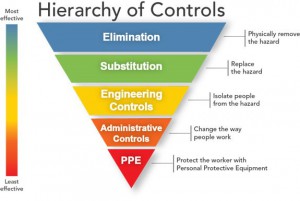June is National Safety Month, and each year the National Safety Council (NSC) highlights a different theme each week.
The first week of June focused on how both employers and employees must be engaged in an effort to improve workplace safety.
Working together, the NSC stressed that employers and employees can develop policies and procedures to identify, monitor, mitigate and eliminate work-related hazards.
The National Institute for Occupational Safety and Health (NIOSH) offers a resource for businesses interested in improving safety in the workplace.
The NIOSH Total Worker Health workbook, “Fundamentals of Total Worker Health Approaches: Essential Elements for Advancing Worker Safety, Health and Wellbeing,” provides checklists for employers to use as they examine their safety policies.
Road safety is the focus of the second week, with an emphasis on reducing work-related crashes.
Motor vehicle crashes are the leading cause of work-related deaths in the United States and the first or second leading cause of death in every major industry group, according to the Bureau of Labor Statistics.
Forty-four percent of the occupational fatalities at road construction sites involved a worker struck by a vehicle in a work zone, the NSC said.
Struck-by injuries are the leading cause of nonfatal injuries and the second most common cause of fatalities among construction workers, the agency added.
From 2011 to 2022, 1,462 fatal occupational injuries were recorded at road construction sites.
The NSC recommends businesses ensure that any employee who drives for work should be considered a fleet driver and trained as such.
Next week’s workplace safety emphasis will be on risk reduction.
The NSC said a guiding principle of reducing risk in the workplace is the hierarchy of controls, a way of determining which actions will best control exposures.
The hierarchy of controls has five levels of actions to reduce or remove hazards with the most effective actions at the top of the pyramid. Using this hierarchy can lower worker exposures and reduce risk of illness or injury.

One of the best ways to prevent and control occupational injuries, illnesses, and fatalities is to “design out” or minimize hazards and risks, the safety agency said.
Exposure assessment is key to improving workplace safety, the NSC emphasized.
June’s final week will focus on slips, trips and falls.
Falls from elevation represented an estimated 81 percent of all fatal and 20 percent of all nonfatal slips, trips, and falls for all industry workers, the agency reported.
Many occurred in the construction industry, with construction workers making up nearly half (49 percent) of all fatal occupational slips, trips, and falls.
Since 2013, construction workers have suffered approximately 300 fatal and 20,000 nonfatal fall-related injuries per year, the NSC reported.
The highest numbers of nonfatal fall injuries are in the health services and the wholesale and retail sectors, according to NIOSH research which found that providing highly-rated slip-resistant shoes to food service workers led to a 67 percent reduction in workers compensation claims for slip injuries.





















 Reporter’s Notebook: ‘Nobody Else Does Telematics,’ Lemonade Exec Says
Reporter’s Notebook: ‘Nobody Else Does Telematics,’ Lemonade Exec Says  Property and Casualty Insurance Trends for 2025
Property and Casualty Insurance Trends for 2025  Surviving the ‘Silver Tsunami’: Closing the Talent, Skills Gap in Underwriting
Surviving the ‘Silver Tsunami’: Closing the Talent, Skills Gap in Underwriting  Insured Losses From Los Angeles Wildfires Rising: $8B to $20B
Insured Losses From Los Angeles Wildfires Rising: $8B to $20B 